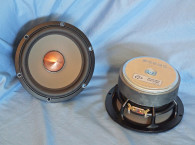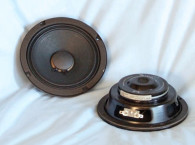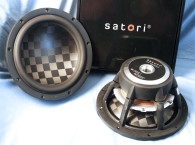


Suspension is provided by a standard NBR surround in conjunction with a black flat 4” diameter spider (damper). For cooling, the frame is completely open beneath the spider mounting shelf, and with no pole vent, substantial air can be pumped past the voice coil and over the front plate. The motor assembly, like that of the W16NX003, is powered by a FEA-optimized overhung ferrite magnet motor design. Driving the cone assembly is a voice coil that consists of a 39 mm (1.5”) diameter titanium former wound with round copper wire. Voice coil tinsel lead wires terminate to a pair of solderable gold-plated terminals.
I began characterizing the W18EX003 again using the LinearX LMS analyzer and VIBox to create both voltage and admittance (current) curves with the driver clamped to a rigid test fixture in free-air at 0.3V, 1V, 3V, 6V, 10V, and 15V. The curve fit on the 15V was not adequate, and was discarded.
Following my established protocol, I no longer use a single added mass measurement and instead this month relied upon the Klippel laser measured Mmd. I post-processed the collected data, the ten 550-point sine wave sweeps for each W18EX003 sample, and divided the voltage curves by the current curves to generate impedance curves, with the phase derived using the LMS calculation method.
I imported them, along with the accompanying voltage curves, to the LEAP 5 Enclosure Shop software. Because T-S data provided by the majority of OEM manufacturers is generated using either the standard model or the LEAP 4 TSL model, I additionally created a LEAP 4 TSL parameter set using the 1 V free-air curves. I selected the complete data set, the multiple voltage impedance curves for the LTD model, and the 1 V impedance curve for the TSL model in the transducer parameter derivation menu in LEAP 5 and created the parameters the computer box simulations.
Figure 1 shows the 1 V free-air impedance curve. Table 1 compares the LEAP 5 LTD and TSL data and factory parameters for both of the W18EX003 samples. LEAP parameter calculation results for the W18EX003 correlated reasonably well with the SEAS factory published data. SEAS does use a somewhat more conservative Sd number, but the effect appears relatively minor here. As usual, I followed my established protocol and proceeded setting up computer enclosure simulations using the LEAP LTD parameters for Sample 1. Two computer box simulations were programmed into LEAP 5, one a QB3 vented enclosure alignment with a 0.37 ft3 volume (15% fill material) tuned to 41 Hz and the second an EBS vented alignment with a 0.79 ft3 volume simulated with 15% fiberglass damping material and tuned to 33 Hz.



Figure 2 displays the results for the W18EX003 in the two enclosures at 2.83 V and at a voltage level sufficiently high enough to increase cone excursion to Xmax + 15% (5.75 mm). The QB3 alignment produced a 3 dB down frequency of 53 Hz (F6 = 44 Hz) and –3 dB= 43 Hz (F6 = 34 Hz) for the EBS vented box simulation.
Increasing the voltage input to the simulations until the maximum linear cone excursion criteria was reached resulted in 106 dB at 21 V for the smaller vented box simulation and the 103 dB at 16.5 V input level for the larger vented enclosure. Figure 3 shows the 2.83 V group delay curves. Figure 4 shows the 21 V/16.5 V excursion curves. In the case of both vented box simulation, excursion goes beyond the 5.75 mm Xmax + 15% number at frequencies lower than about 30 Hz, so a 30 Hz to 35 Hz steep (24 dB/octave) high-pass filter would be a useful addition and prevent over excursion and distortion.





Klippel analysis for the W18EX003 produced the Bl(X), Kms(X) and Bl and Kms symmetry range plots given in Figures 5-8. The Bl(X) curve for the W18EX003 (see Figure 5) is moderately broad and symmetrical, with a very small amount of coil-out offset as well as trivial amount of tilt. Looking at the Bl symmetry plot (see Figure 6), the displacement is a meaningless 0.12 mm at the physical Xmax of 5mm.
Figure 7 and Figure 8 show the Kms(X) and Kms symmetry range curves for the W18EX003. The Kms(X) curve is somewhat asymmetrical in both directions, as well as having small amount of coil-out offset. Looking at the Kms symmetry range plot shown in Figure 8, there is a constant 1.3 mm coil-out offset suggesting a forward coil position. This is probably intentional and part of the subjective tuning process for this driver.
Displacement limiting numbers, calculated by the Klippel analyzer for the SEAS W18EX003, were XBl at 82% Bl = 6.2mm and for XC at 75% Cms minimum was 4.9 mm, which means that for this 6.5” driver, the compliance is the most limiting factor for prescribed distortion level of 10%, however the compliance numbers are just about at the physical Xmax of this driver, so not an issue.
Figure 9 gives the inductance curves L(X). Inductance will typically increase in the rear direction from the zero rest position as the voice coil covers more pole area, however because of the extensive use of copper shorting rings and the solid copper phase plug, inductance decreases in the rear (coil-in) position. From Xmax out to Xmax in, the inductance range only varies by 0.01 mH, which is seriously excellent inductive performance.





With the Klippel testing completed, I mounted the W18EX003 in a foam-filled enclosure that had a 15” × 8” baffle and then measured the device under test (DUT) using the Loudsoft FINE R+D analyzer and the GRAS 46BE microphone both on and off-axis from 200 Hz to 20 kHz at 2 V/0.5 m normalized to 2.83 V/1 m (one of the really outstanding tricks FINE R+D can do) using the cosine windowed FFT method. All of these SPL measurements also included a 1/12 octave smoothing.
Figure 10 shows the W18EX003’s on-axis response indicating a rather smooth rising response with a typical small rise in the 1 kHz region with the magnesium break up modes starting at about 5 kHz where the driver begins its low-pass roll-off. Figure 11 displays the on- and off-axis frequency response at 0°, 15°, 30°, and 45°, showing somewhat more directivity than most home audio 6.5” woofers, remembering this is a flat rather than a curvilinear cone.
The -3 dB at 30 degrees with respect to the on-axis curve occurs at 2.1 kHz, so a cross point in that vicinity should work well to achieve a good power response. Figure 12 gives the normalized version of Figure 11. Figure 13 shows the CLIO horizontal polar plot (in 10° increments). And finally, Figure 14 gives the two-sample SPL comparisons for the W18EX003, showing a close match (less than 1 dB) throughout the operating range.
For the remaining series of tests, I again employed the Listen Inc. SoundCheck AudioConnect analyzer and SCM microphone to measure distortion and generate time-frequency plots. For the distortion measurement, I mounted the W18EX003 rigidly in free-air and set the SPL to 94 dB (4.55 V) at 1 m, using a pink noise stimulus. Then, I measured the distortion with the Listen, Inc. microphone placed 10 cm from the driver.



This produced the distortion curves shown in Figure 15. I then employed the SoundCheck software (Version 17) to get a 2.83 V/1 m impulse response for this driver and imported the data into Listen’s SoundMap Time/Frequency software. Figure 16 shows the resulting CSD waterfall plot. Figure 17 shows the Wigner-Ville plot (chosen for its better low-frequency performance).
Looking at all the data I collected for the new Magnesium/Graphene cone SEAS W18EX003, even without doing any kind of subjective evaluation, this definitely looks like a very well-crafted product. This driver and the similar W16NX003 readily portrays the kind of engineering integrity and high-build quality you would expect from this iconic Norwegian high-end OEM driver manufacture.
From its founding in 1950 as a spin-off of the Norwegian radio manufacturers Radionette and Tandberg, SEAS Fabrikker has been dedicated to creating loudspeakers with superior sound reproduction. The company, whose name means Scandinavian Electro Acoustic Systems, has remained in the forefront of European driver manufacturing for more than 60 years. For more information, visit the SEAS website at www.seas.no. VC
This article was published in Voice Coil, August 2019.







